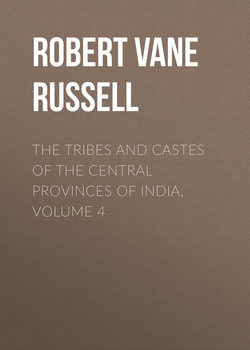Читать книгу The Tribes and Castes of the Central Provinces of India, Volume 4 - Robert Vane Russell - Страница 35
Part II
Articles on Castes and Tribes
Kumhār—Yemkala
Vol. IV
Kunbi
22. Clothes and ornaments
ОглавлениеThe dress of the ordinary cultivator is most common-place and consists only of a loin-cloth, another cloth thrown over the shoulders and upper part of the body, which except for this is often bare, and a third rough cloth wound loosely round the head. All these, originally white, soon assume a very dingy hue. There is thus no colour in a man’s everyday attire, but the gala dress for holidays consists of a red pagri or turban, a black, coloured or white coat, and a white loin-cloth with red silk borders if he can afford it. The Kunbi is seldom or never seen with his head bare; this being considered a bad omen because every one bares his head when a death occurs. Women wear lugras, or a single long cloth of red, blue or black cotton, and under this the choli, or small breast-cloth. They have one silk-bordered cloth for special occasions. A woman having a husband alive must not wear a white cloth with no colour in it, as this is the dress of widows. A white cloth with a coloured border may be worn. The men generally wear shoes which are open at the back of the heel, and clatter as they move along. Women do not, as a rule, wear shoes unless these are necessary for field work, or if they go out just after their confinement. But they have now begun to do so in towns. Women have the usual collection of ornaments on all parts of the person. The head ornaments should be of gold when this metal can be afforded. On the finger they have a miniature mirror set in a ring; as a rule not more than one ring is worn, so that the hands may be free for work. For a similar reason glass bangles, being fragile, are worn only on the left wrist and metal ones on the right. But the Dhanoje Kunbis, as already stated, have cocoanut shell bangles on both wrists. They smear a mark of red powder on the forehead or have a spangle there. Girls are generally tattooed in childhood when the skin is tender, and the operation is consequently less painful. They usually have a small crescent and circle between the brows, small circles or dots on each temple and on the nose, cheeks and chin, and five small marks on the back of the hands to represent flies. Some of the Deshmukh families have now adopted the sacred thread; they also put caste marks on the forehead, and wear the shape of pagri or turban formerly distinctive of Marātha Brāhmans.
